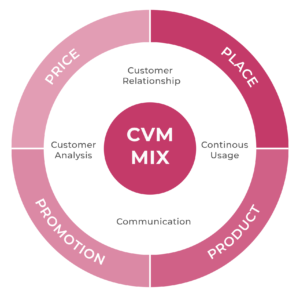This section of the CVMBoK takes on the task of systematizing the entire CVM area and proposing a comprehensive framework to understand it.
Connection Between CVM and Marketing #
Customer Value Management isn’t an isolated discipline; it is fundamentally a subset of the broader discipline of Marketing.

What is Marketing: Philip Kotler’s 4P Marketing Mix
Philip Kotler, a renowned marketing expert, has contributed significantly to the field of marketing. His concepts, including the famous 4Ps (Product, Price, Place, Promotion), have been foundational in marketing. For a comprehensive exploration of CVM’s roots within marketing, consider reading Philip Kotler’s latest edition [1], which provides valuable insights into this evolving discipline. The 4Ps identified by Kotler are:
- Product – the creation of offerings that meet the needs and desires of the target market.
- Price – setting a price that reflects the perceived value of the product while considering market demand and competition.
- Place – making the product available in the market and distributed to locations where it is convenient for consumers to buy it, physically or virtually.
- Promotion – managing price changes, reaction to the market and stimulation of the demand with campaigns to maximize the overall sales.
Moving beyond 4Ps of Marketing #
However, while Marketing forms the source for CVM, it goes today far beyond the traditional 4Ps. Specifically, CVM places much greater emphasis on aspects that were not so relevant at the time of 4Ps invention, but are extremely important nowadays. The specific characteristics which CVM emphasizes are:
- Customer Analysis: We have many customers whom we can individually analyze;
- Continuously Usage: Our products are subscription like or used continuously;
- Customer Relationship: There is an ongoing customer relationships with contractual renewal cycles and multiple purchases;
- Communication: We can have direct communication with individual customers, either via telephone (call center, telemarketing) or digitally (email, apps, web, etc.), and periodic interactions in person (in retail stores or in other face-to-face meeting formats).
Adding these 4 additional “C”s significantly expands the original 4Ps. It is a much deeper and wider framework that builds on top of marketing but adds may important twists. It is essentially a modern reincarnation of direct marketing, fueled by Big Data, powered by Generative AI, and accelerated by Digital Transformation and the Cloud.
Many industries are experiencing the fact that “marketing with CVM characteristics” is gaining in importance. Such industries are:
- Telecommunications
- Media and television
- E-commerce
- Gaming and mobile apps
- Fintech and banking
- Insurance
- Energy
- Automotive
- Consumer products, especially with digital add-ons
- Etc.
What is CVM: A 4P+4C framework #
This CVMBoK accordingly proposes to conceptualize and define modern Customer Value Management by using 4Ps+4Cs framework:

What is CVM: 4P (Product, Price, Place, Promotion) + 4C (Customer Analysis, Continuous Usage, Customer Relationship, Communication)
Customer Value Management is a business management discipline that focuses on 8 aspects:
- Product – the creation of offerings that meet the needs and desires of the target market.
- Price – setting a price that reflects the perceived value of the product while considering market demand and competition.
- Place – making the product available in the market and distributed to locations where it is convenient for consumers to buy it, physically or virtually.
- Promotion – managing price changes, reaction to the market and stimulation of the demand with campaigns to maximize the overall sales;
- Customer Analysis – using data to understand the customer’s needs, behaviors, and preferences in order to tailor products and services.
- Continuous Usage – encouraging repeated use of the product through meeting of the customer needs and providing a commercial architecture that encourages easy trial and gradual growth of spend;
- Customer Relationship – building and maintaining long-term relationships with customers to enhance loyalty and lifetime value, servicing and educating the customer, and more.
- Communication – communicating the benefits of the product to the target audience through various channels, campaigns and strategies to ensure that the right message reaches the customer through the most effective channels at the right time.
As can be readily seen CVM is a holistic discipline that integrates product marketing and development, pricing, distribution, promotional activities, communication and branding, and customer focused processes to create a strong, sustainable relationship with the customer base. It may be tempting to treat CVM more narrowly, for example focusing on customer retention and upselling/cross-selling, but we believe this simply hides the true nature of the discipline. Let’s recognize this complexity and then deal with it accordingly.
The Broad Scope of CVM #
CVM includes some level of responsibility for a broad spectrum of ongoing operational as well as transformational activities related to 4Ps+4Cs, spanning approximately 14 distinct areas.

14 areas coordinated by CVM
The Dual Nature of CVM #
In addition to the 14 areas coordinated by CVM, it is important to recognize a crucial Customer-Company duality at the core of CVM. To truly grasp the essence of customer value management (CVM), one must view it from two major perspectives:
- Company perspective: CVM is oriented towards achieving business results, maximizing revenue;
- Customer perspective: CVM seeks to address and fulfill customer needs in the best way possible.
This duality persists across the entire discipline, with different companies placing emphasis on different parts of the dual nature. Some companies practice CVM mainly from a business-focused perspective, while others firmly take a customer-centric perspective. The balance between these two approaches varies, and there is no single right or wrong approach – it depends on the specific context and objectives of each organisation.
To sum up, CVM can be defined as a management discipline responsible for 4P+4C, coordination of 14 areas contributing to CVM, creating and maintaining the desired balance of Customer-Company duality, and alignment across the entire customer lifecycle.
Modern, digital, data-rich business environment strongly favors an enriched definition of marketing with CVM characteristics. The future of business success lies in customer value management excellence.
CVMBoK © 2023 by Exacaster is licensed under CC BY-NC 4.0



